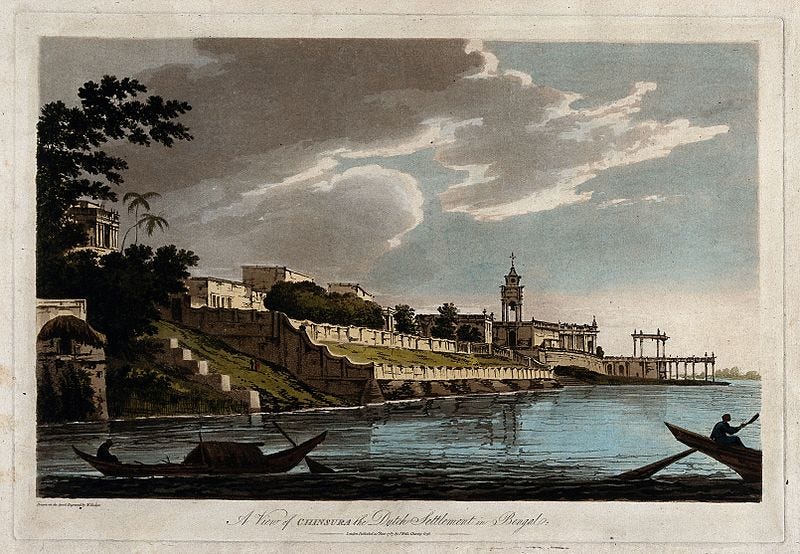
History is gigantic along multiple dimensions, so it’s hardly surprising that there are countless combinations of time and place that you or I have never considered. Occasionally, though, I come across a blindspot that is perplexing: an event that seems significant, but that almost no one seems to be thinking about.
The proto-industrialized period of Bengal is one such blindspot. I’m guessing that, unless you come from South Asia or are a really big history nerd, you probably have no idea what I even mean by “the proto-industrialized period of Bengal.”
We’ll clarify everything later in the post, but for now, you should know that:
- Bengal is a region of the Indian subcontinent, shared today between India and Bangladesh.
- Proto-industrialization is an economic phenomenon in which a pre-industrial society produces a lot of crafts, such as textiles, which it sells to external markets. It is often considered to be a precursor to industrialization.
- The proto-industrialized period of Bengal refers to the time before British colonization, roughly from 1600 to 1750. Bengal was then a part of the Mughal Empire, and it had a prosperous craft-based economy.
This was a period of great wealth: Bengal was responsible for most of India’s GDP, which was itself about 25% of the world’s economy. The Mughal emperors called it “the Paradise of Nations.”
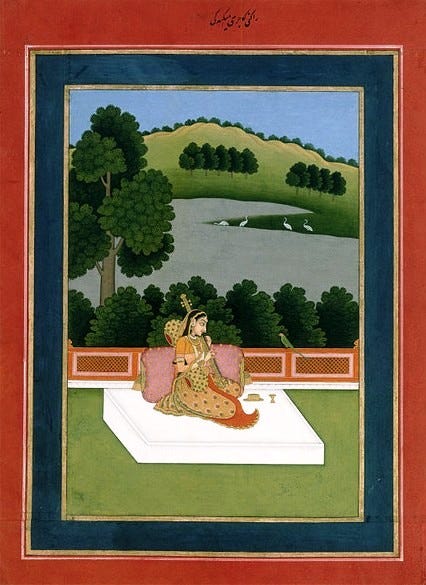
Yet, despite this high level of economic development, Bengal didn’t industrialize. The only country that ever did without copying another was Great Britain, starting around 1760. This was a momentous event that changed history forever, which is why we call it the Industrial Revolution.
Why didn’t that happen in Bengal instead?
This seems like an important question for people who, like me, are interested in the history of progress. But to my knowledge, very little popular content has been written about proto-industrialized Bengal. Sure, if you dig enough, you’ll find some scholarly articles and specialized books. But digestible introductions are almost nonexistent outside of Wikipedia. The subreddit r/AskHistorians, for instance, has at least four relevant questions about pre-colonization Bengal (here, here, here, and most recently here), but none of them has received a single answer yet.
(If you go back eight years in the r/AskHistorians archives, there was some discussion of how Bengal went from rich to poor, which is topical, but more about what came after the proto-industrialized period, i.e. British colonization. We’ll cover the involvement of Britain later in the post.)
I’m on record for saying that there should be a good blog post about Bengali proto-industrialization. What you’re reading … is probably not that blog post. I am merely an amateur historian, and this post is the result of only a few weeks of research. I’ve only scratched the surface.
Still, if you’re like me, the history of the Indian subcontinent in general is a giant blindspot, and even an amateur introduction to Bengali history will be helpful. If it inspires people to think about industrialization and progress beyond the way they happened in Europe, that’ll be a success. (And if you spot any errors, let me know and I’ll fix them!)
The rest of this post contains four parts: (I) some context about Bengal, (II) a description of the proto-industrialized period, (III) the European colonization and subsequent deindustrialization, and (IV) a conclusion with some speculative thoughts. It’s a bit long, but there are a lot of pictures.
I. What Is Bengal, Exactly?
Readers from South Asia will forgive me for saying that most other people are confused by the word “Bengal.” I certainly used to be. Is Bengal a country? A region? A people? A bay? A cat breed? A subspecies of tiger? All of the above?
The answer is something like “a geopolitical, cultural and historical region of the Indian subcontinent, in and around the Ganges delta, just north of the Bay of Bengal.” Basically, it’s the homeland of the Bengali people, who speak the Bengali language. At certain points in history, the Bengali people formed independent countries, such as the Pala Empire a thousand years ago, or the Bengal Sultanate from 1352 to 1576. At other points, the Bengali people were incorporated into larger foreign-controlled countries, such as the Mughal Empire and the British Empire.
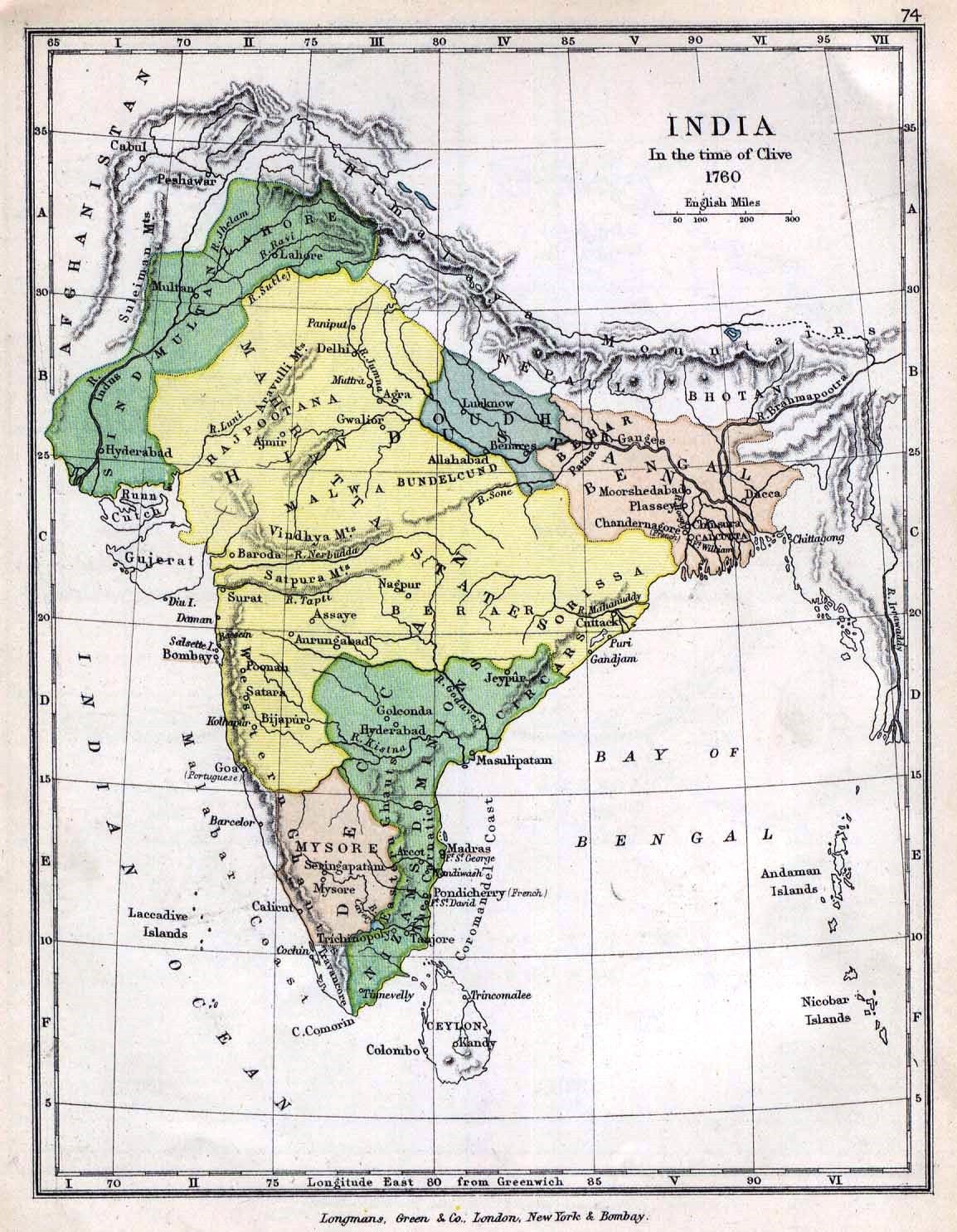
Today, to confuse everyone, Bengal is both an independent country and part of a larger country. This is the result of the Partition of India, a complicated event that happened in 1947, when British India became independent. The colony was split into two countries: the Hindu-majority Dominion of India, and the Muslim-majority Dominion of Pakistan. Bengal had people of both religions, so it was partitioned into West and East Bengal.

West Bengal was the Hindu region, and eventually became a state in the Republic of India, with its capital at Kolkata (or Calcutta). East Bengal was Muslim, and was a province of Pakistan, which was awkward because most of Pakistan was far away, on the other side of India. The Pakistani Bengalis wanted self-determination, and so there was a war between the two Pakistans, including a genocide inflicted on the East by the West, and then the People’s Republic of Bangladesh was created in 1971-72, with its capital at Dhaka (or Dacca).
And so today there’s an independent Bengali country, mostly Muslim, called Bangladesh (which literally means “Bengali country” in Bengali); and a non-independent Bengali country, mostly Hindu, called West Bengal. They have their cultural differences, of course, but in a sense they’re still the same people. And they’re a big people: worldwide, there are about 300 million Bengalis. Their language is the seventh-most spoken in the world. Kind of absurd that I know so little about them.
The reason there are so many Bengalis is that Bengal is a naturally rich region. The Ganges delta is the largest river delta in the world, and it’s a wonderful place to practice agriculture. It looks like this:
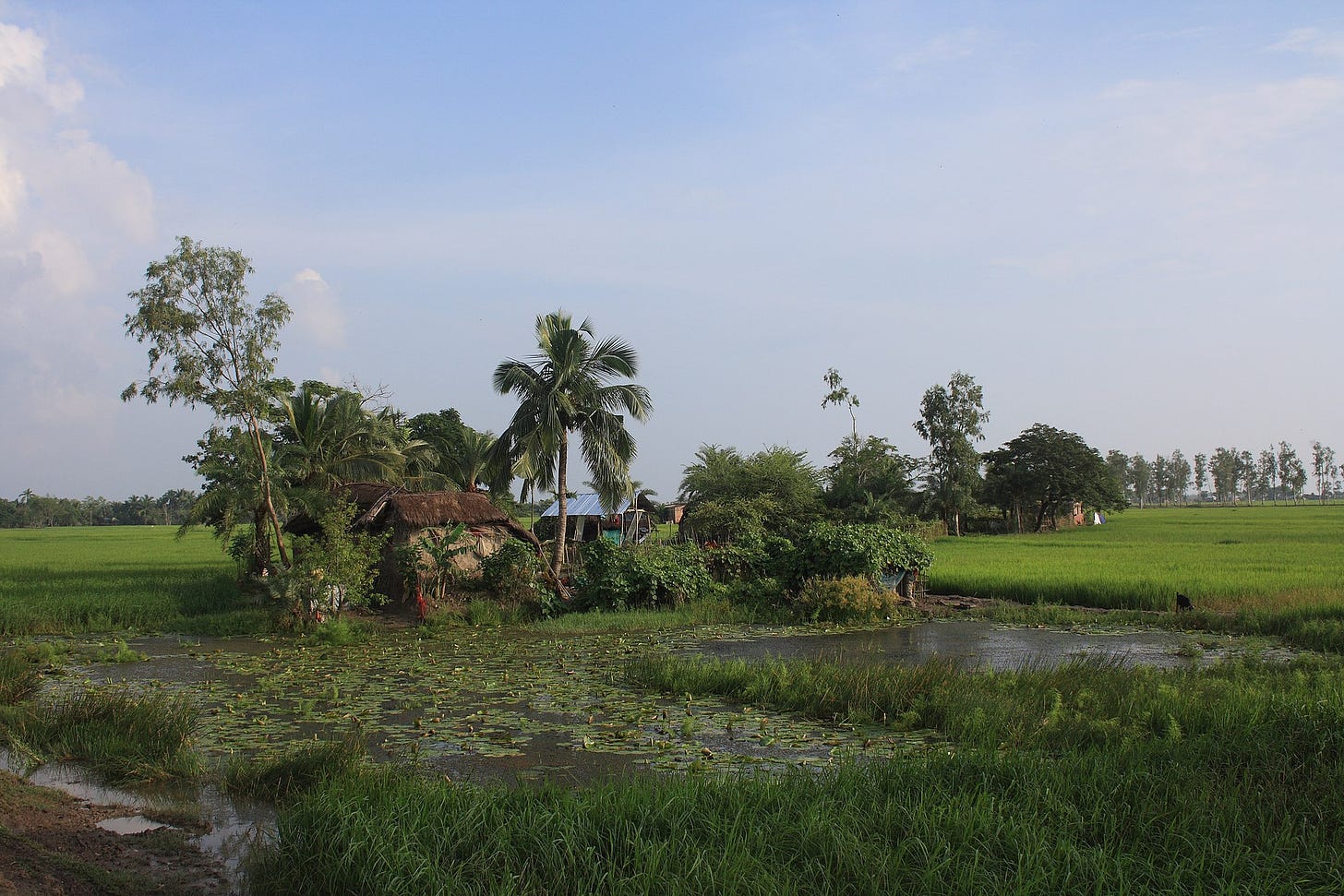
A fertile land means a large population, and a large population, to a first approximation, means wealth. Bengal was an important place from antiquity onwards; it traded far and wide, including with the Arabs, which led to the spread of Islam. It tended to become the richest part of whatever Indian dynasty incorporated it into its empire.
This happened in 1576 with the Mughals, a Muslim dynasty of Central Asian origin who ruled most of India from the northwest, in Agra and Delhi. Bengal was the largest, most populated, and wealthiest subah (province) of the Mughal Empire.
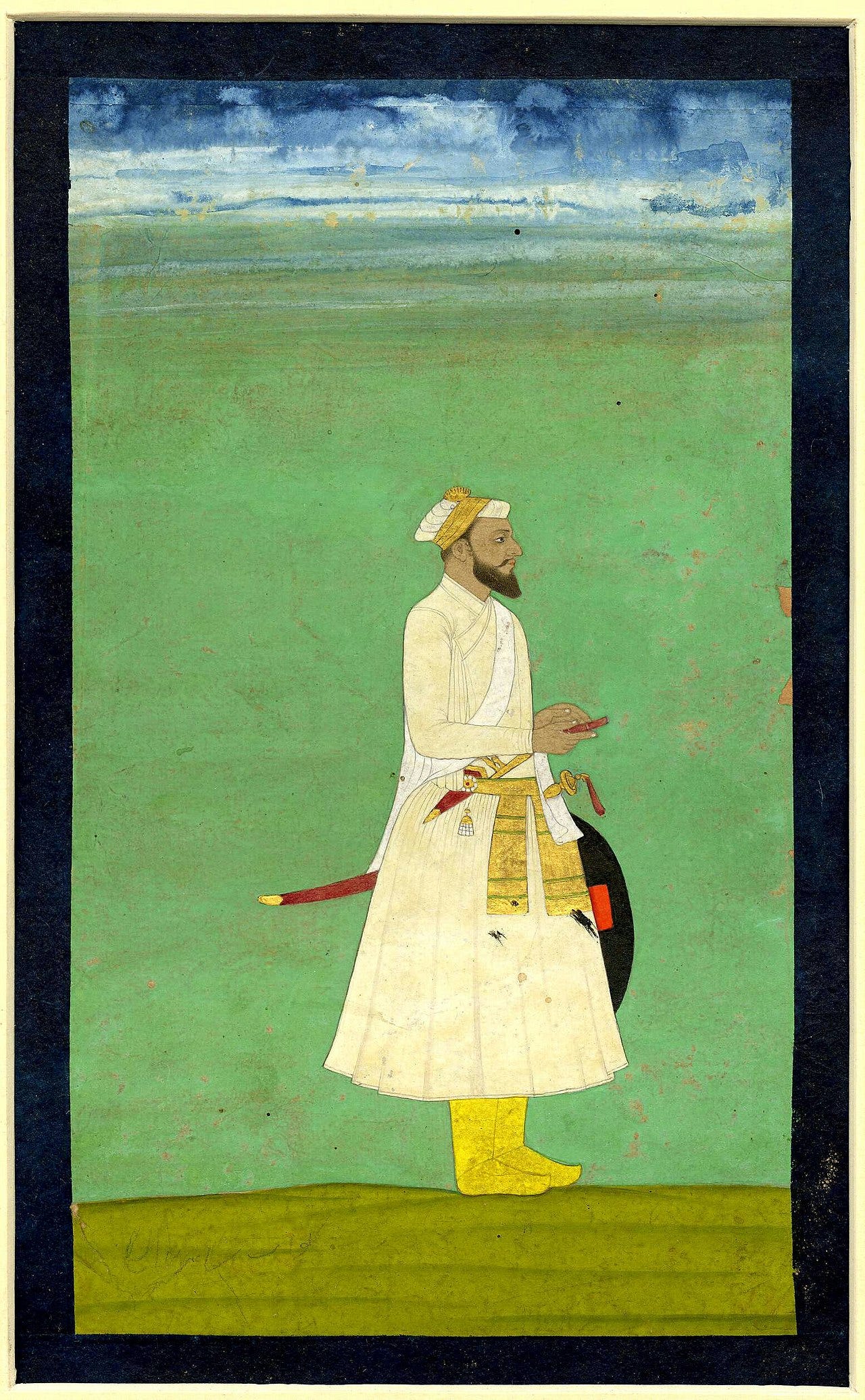
The Mughals ruled Bengal directly until 1717, and then nominally during a period of quasi-independence under the Nawabs (governors) of Bengal. That lasted until 1757, when the British began the process of taking over. The period from about 1600 to 1750 was, in many ways, the golden age of Bengal. It was the Paradise of Nations. It was beginning to industrialize. It was the center of the world.
What did that look like?
II. Proto-industrialization in the Paradise of Nations
A simplified model of society evolution goes: hunter-gatherers → subsistence farmers → industrial laborers. If you’re reading this, you’re almost certainly living in a society that has reached the industrial stage. But the vast majority of complex societies in history were stuck at the agrarian stage for thousands of years.
Agrarian and industrial societies look very different. In an agrarian society, most people are busy growing their own food, and typically give their surplus (as tax) to a small elite of nobles and priests, whose lifestyle is supported by a small middle class of merchants and craftsmen. In an industrial society, techniques for harnessing energy and manufacturing goods allow agricultural and material production to skyrocket, leading to a proportionally small class of farmers and a large class of industrial laborers, replacing craftsmen.
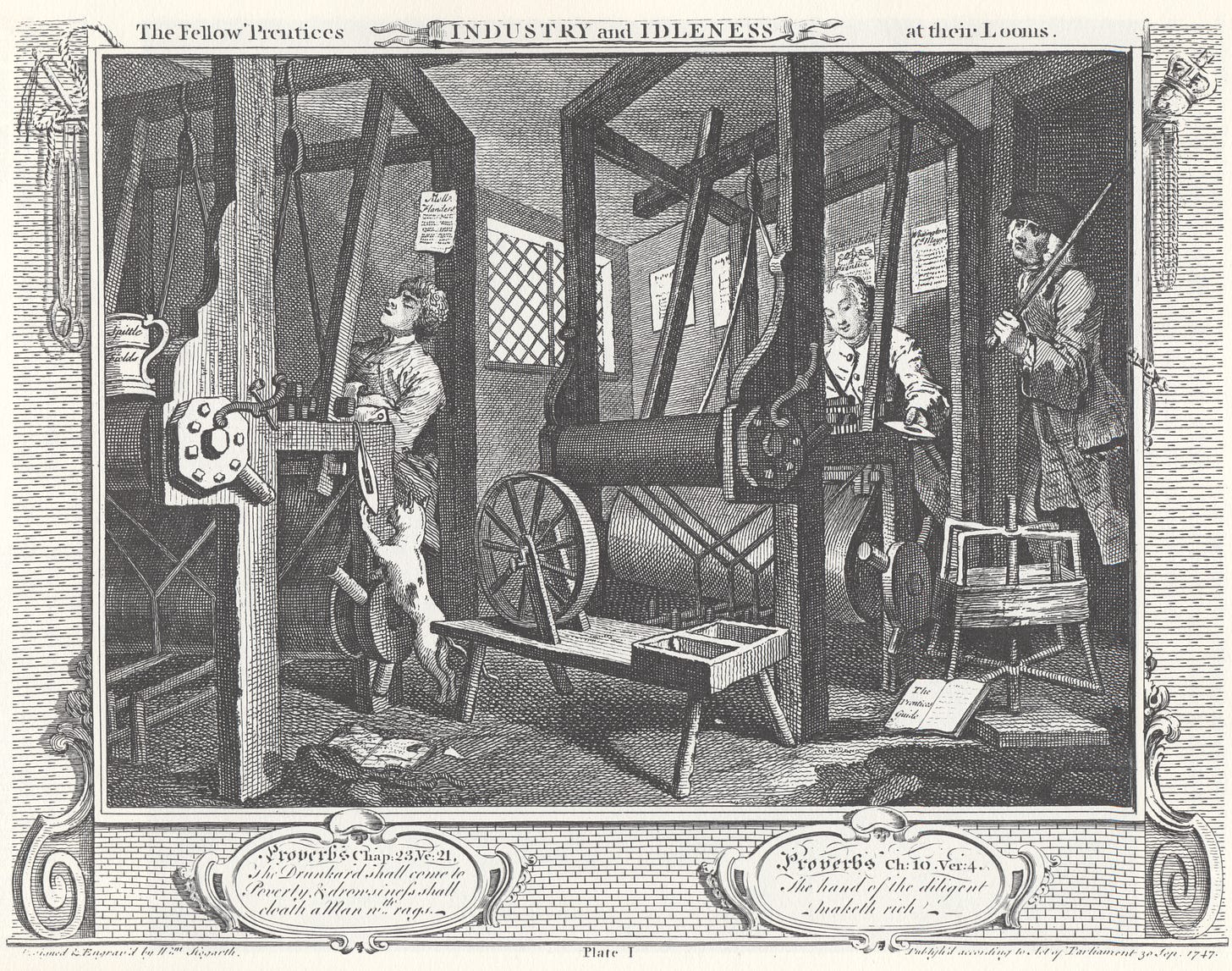
The proto-industrial society is a transition stage between the two. Most of the society is still agrarian, but farmers become able to focus less on growing food and more on cash crops that can be sold for profit. At the same time, craftsmen rise in importance: despite the lack of industrialization hallmarks such as machine tools or fossil fuels, the production of crafts — textiles, pottery, ships, metalwork, etc. — begins taking a larger place in the local economy. Notably, many of these crafts are intended for export, bringing further wealth into the proto-industrialized region.
Proto-industrialization is a relatively recent concept and a point of debate for economic historians, but it seems to have happened in many regions of Europe in the centuries before the Industrial Revolution. It has also been identified in China during the Song dynasty (960-1279) and, of course, in Mughal India.
A big reason why I wrote this post is that I couldn’t find a clear picture of what proto-industrialization may have looked like outside of Europe. The sources that focus on economic history tend just throw numbers at you, which is fine, but doesn’t really create a coherent view of the place.
Still, numbers are important, so let me throw them at you in turn:
- Bengal as a whole had about 30 million people in 1769 (before the great famine of 1770), more than either Great Britain or France.
- Dhaka, the Bengali capital, had more than a million inhabitants in the 1600s and 1700s, making it one of the largest cities worldwide. [ADDENDUM: This is an enormous figure with no clear source, so we should probably be skeptical. Perhaps there were a million people, but spread out over a large area.]
- Dhaka also had no less than 80,000 skilled textile weavers.
- There was a large shipbuilding industry; the total tonnage of ships built in Bengal was 223,250 tons per year, compared to 23,061 for the North American colonies in 1769-71.
- A large proportion (40%) of Dutch imports from Asia came singlehandedly from Bengal, including 50% of textiles and 80% of silk.
- Until 1750, India as a whole produced about 25% of the world’s industrial output (that number was only 2% in 1900) and had a larger GDP than either China or Europe.
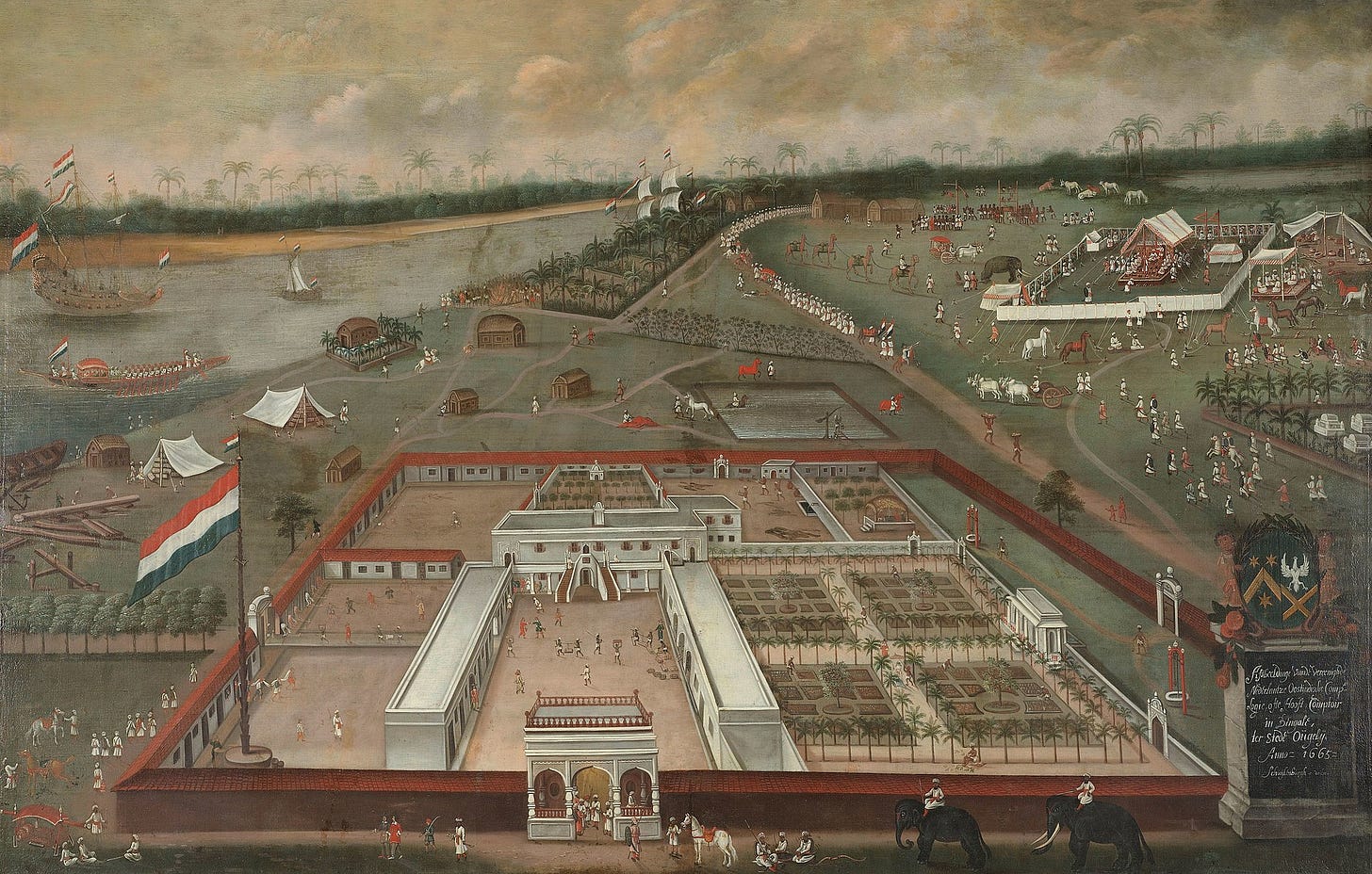
So, the numbers show that Bengal had a large population and a strong economy. But what exactly did it produce?
The most important goods were textiles: cotton, jute, and silk, to which we can add indigo dye. The raw materials were grown locally and then transformed into usable fabric by weavers. Cotton in particular was processed in a number of ways. The most famous cotton textile was muslin, a very light cloth that became hugely popular in Europe. It was reportedly made in a complex 16-step process that is now lost.
Beyond textiles, Bengal also grew several other cash crops. Opium, sugarcane, tobacco, and pepper were some of the big ones. It also, of course, grew food, notably a lot of rice (some of which was exported). During the Mughal period, trade with foreigners additionally brought many agricultural improvements to the region, such as grafting techniques for mangoes and oranges, and the introduction of the potato, maize, and other New World crops.
The mineral resources produced by Bengal notably included saltpeter, a key ingredient of gunpowder. The region also exported steel and other metalwork. Forests were plentiful — the Mughals cleared much of the Ganges delta forests to make space for agriculture — and presumably provided wood for burning and for the prosperous shipbuilding industry.
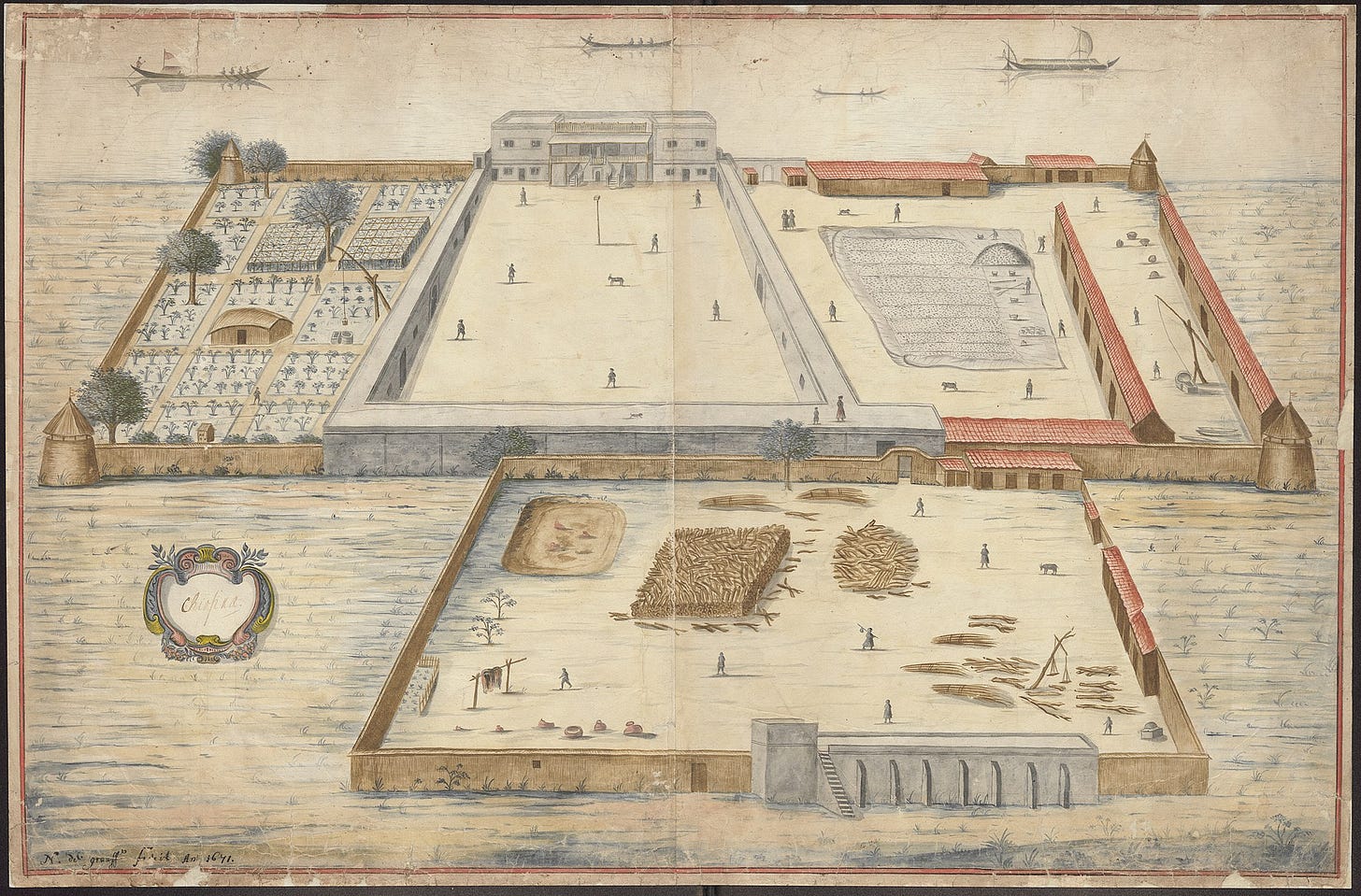
Supporting all of this were a number of technological innovations. The Bengalis invented the flush deck for ships, a design that was later copied by the British. In farming, they adopted the seed drill (from China) before the Europeans did. They also made use of the Indian-invented cotton gin with a worm gear and crank handle to spin threads more effectively.
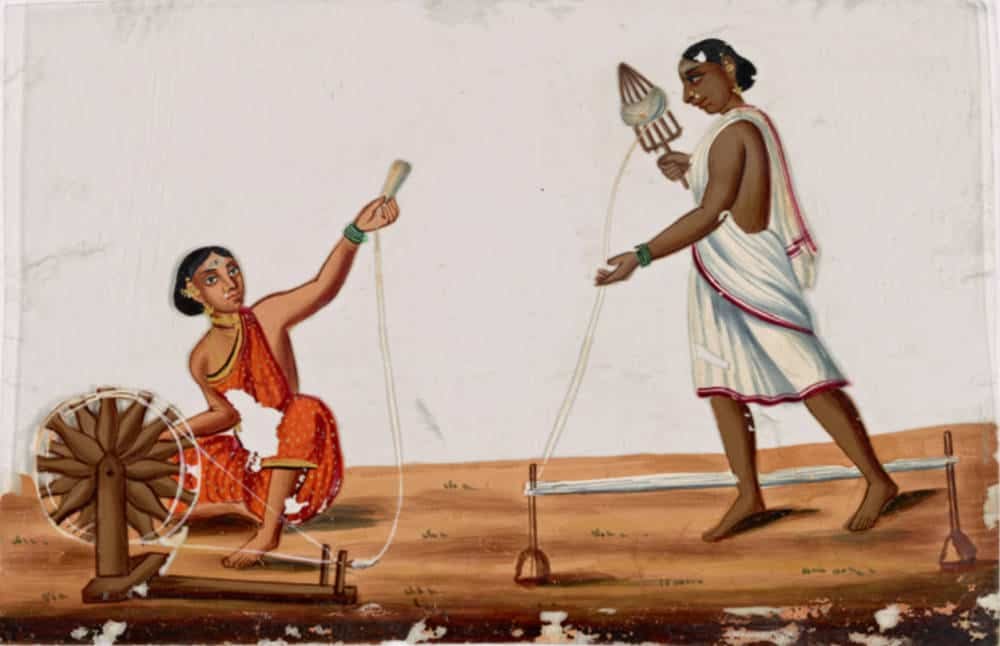
Okay, so now we have an idea of what Bengali production was. But what about the wider society? What did life feel like?
Politically, Bengal was under the rule of a Mughal viceroy (who would later become the autonomous and hereditary Nawab). The next highest social class consisted of an aristocracy established by the Mughals, called the jagirdars or zamindars. They held much of the land and managed the plantation economy that grew all the cotton, indigo, rice, etc., in a way not altogether different from plantation owners in the southern US. Most farmers were tenants on zamindar land, paying rent to the aristocracy, who then paid part of it as tax to the imperial government. Of course, the peasants at the bottom were usually ruthlessly exploited.
This class structure was a contributor to the proto-industrialization of Bengal. The zamindars had a financial incentive to force their tenants to grow cash crops, which were more profitable than staple foods when sold to the cities and external markets. At the same time, the bottom class people had an incentive to supplement their farming income by working in the proto-industries. If your family was having trouble growing cotton (or whatever) for the local zamindar, you could go weave fabric (or whatever) in a workshop for a bit, in exchange for a wage.
There seems to be some debate on how high exactly the standards of living were. Some historians believe that they were probably comparable to those in Europe, though there isn’t much data. Weavers, at least, had some control over their work terms and had better conditions than European weavers. Of course, there must have been a difference between, say, a highly skilled artisan and an unskilled day laborer. And then, at the top, there were the people who had fabulous lifestyles as aristocrats, merchants, and bankers.
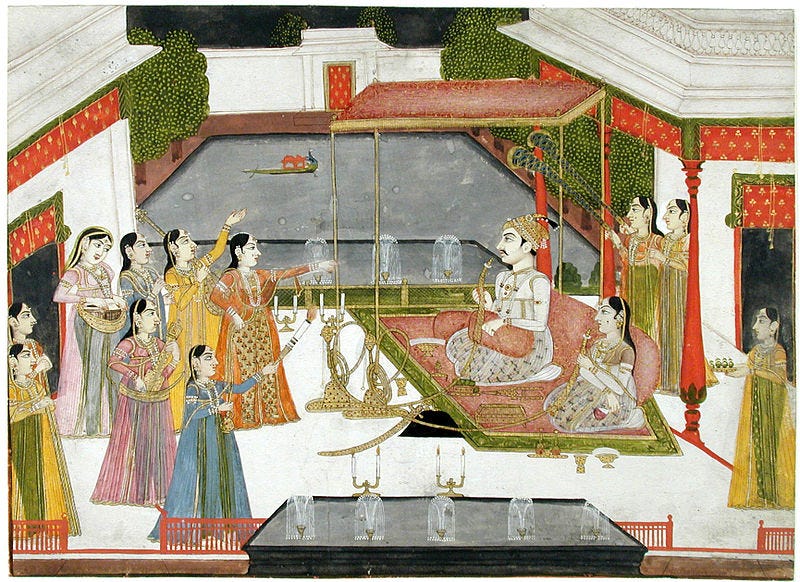
Religiously, Mughal Bengal was, like today, a majority Muslim and minority Hindu place. I’ve read in a few places that the ideas in Islamic economics may have played a major role in proto-industrialization, but I haven’t been able to understand how exactly. The sources points to the Fatawa al-Alamgir, a comprehensive law document (a Sharia) published by Mughal emperor Aurangzeb in the late 17th century, which established the legal system of Muslim India. It seems likely that the Fatawa greatly influenced the economy of the Bengal Subah, but I don’t know through what mechanisms.
Geographically, the Mughal period saw an expansion of the available land, thanks to agrarian reforms and clearances of forested areas in the Ganges delta. This had major impacts on the structure of the population. Besides, the large number of waterways on the Bengal territory was also a factor that helped it industrialize, since that made it easy to move resources and crafted goods around to process and sell them.
Bengal was also relatively urbanized. We already saw that Dhaka was a very large city for its time. It was the capital of Bengal starting in 1608, as well as the center of the muslin proto-industry. Under the rule of governor Shaista Khan (whose portrait we saw above) in the 1660s-80s, Dhaka developed greatly. It got, among other things, this fine mosque:
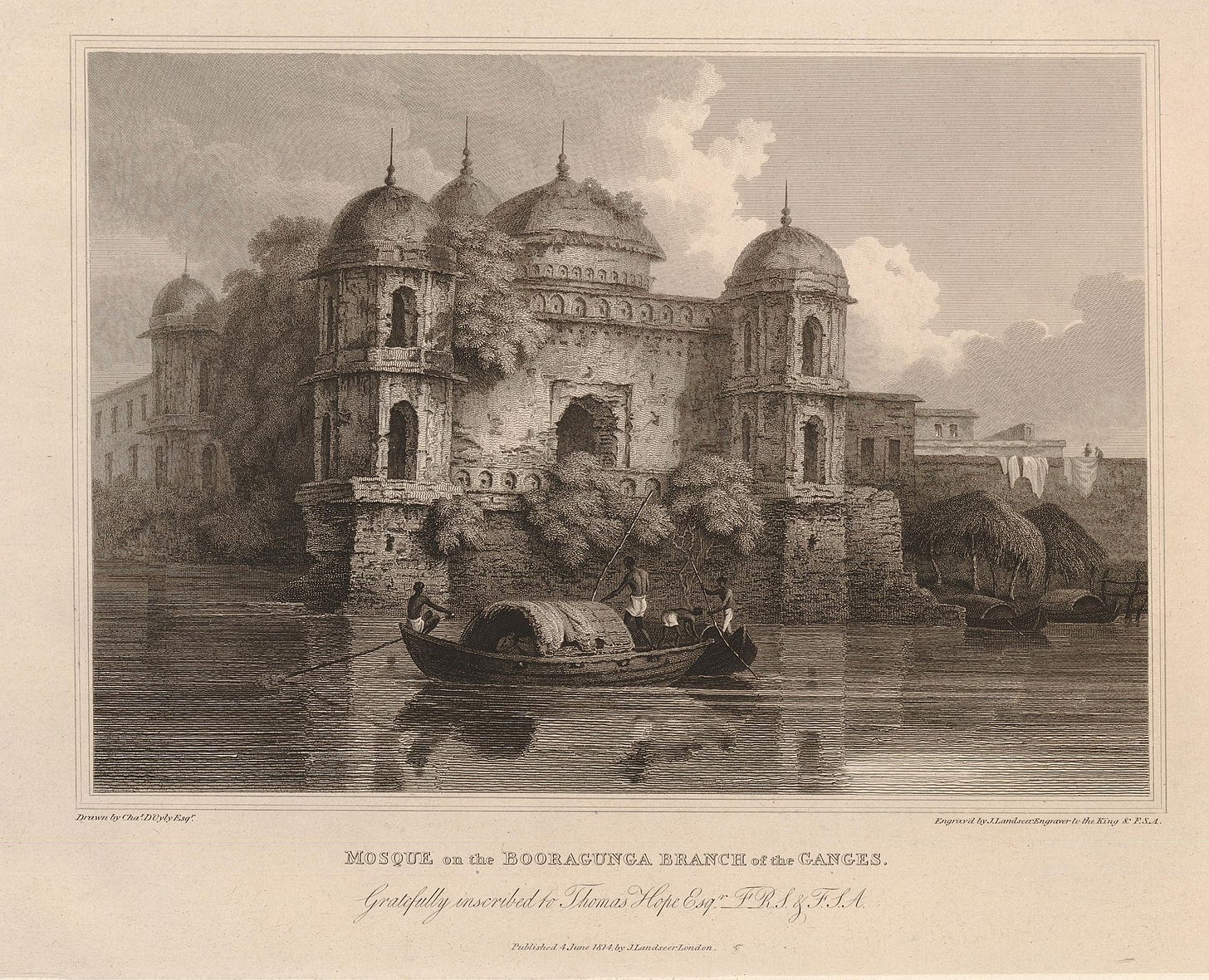
which today looks like this:
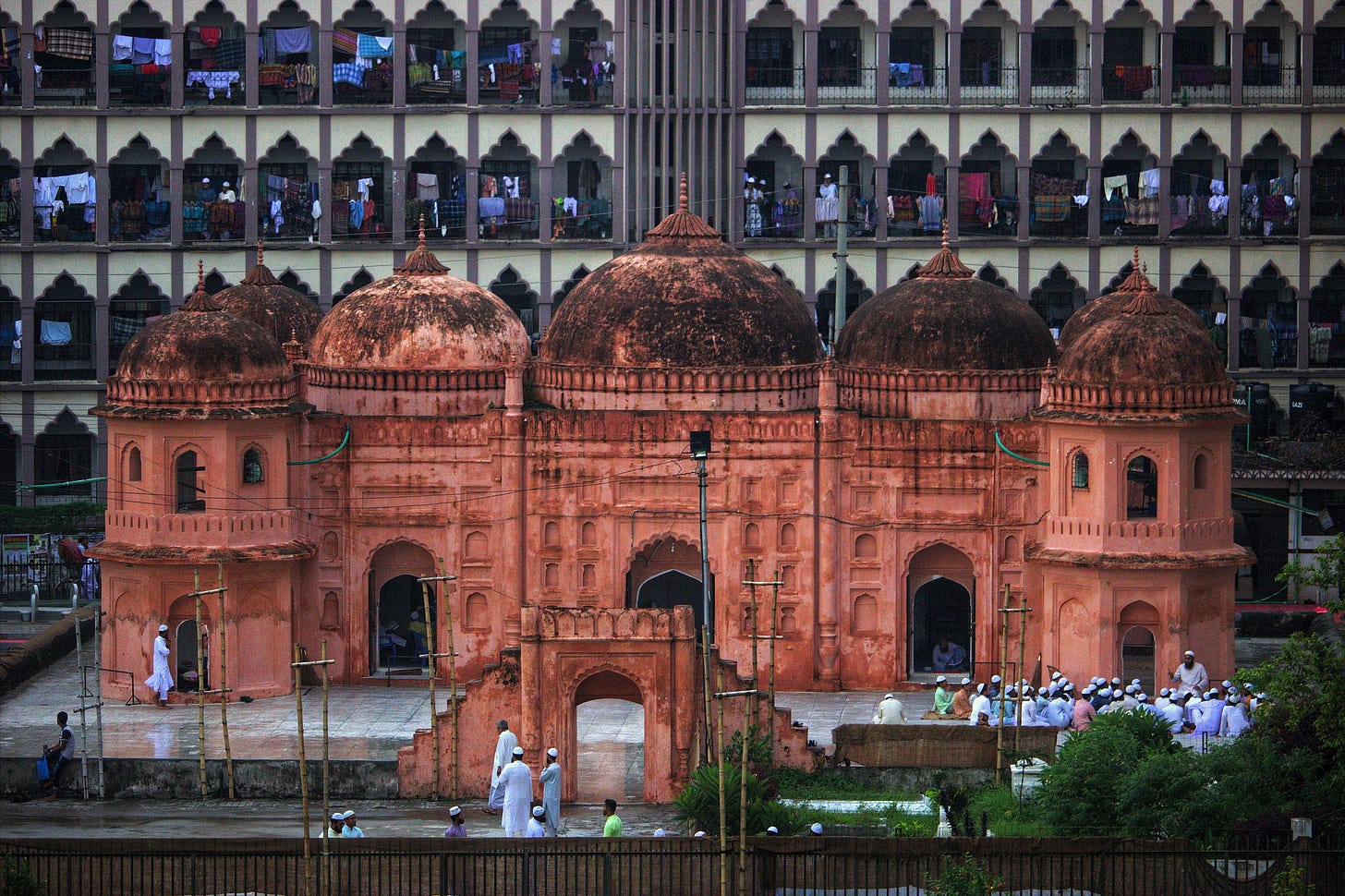
Dhaka also boasted this incomplete but beautiful fort:

To get an impression of Dhaka in its period of growth, here is a description from 1666 by a French traveller, Jean-Baptiste Tavernier (look up his Wikipedia page for a cool portrait in an “oriental costume”). Emphasis mine in all quotes:
Dacca is a large town, which is only of extent as regards length, each person being anxious to have his house close to the Ganges. . . . [F]rom the last brick bridge, which I have mentioned above, up to Dacca, there is a succession of houses, separated one from the other, and inhabited for the most part by the carpenters who build galleys and other vessels. These houses are, properly speaking, only miserable huts made of bamboo, and mud which is spread over them. Those of Dacca are scarcely better built, and that which is the residence of the Governor is an enclosure of high walls, in the middle of which is a poor house merely built of wood. He ordinarily resides under tents, which he pitches in a large court in this enclosure.
The Dutch, finding that their goods were not sufficiently safe in the common houses of Dacca, have built a very fine house, and the English have also got one which is fairly good. The church of the Rev. Augustin Fathers is all of brick, and the workmanship of it is rather beautiful.
Beyond the fact that Mr. Tavernier apparently hated wooden houses compared to brickwork, it’s interesting to note the importance he gives to the shipbuilders. Meanwhile, another European traveler from that era, Thomas Bowrey, was more appreciative of the city:
The City of Dhaka is a very large, spacious one, but stands on low, marshy, swampy ground, and the water of that ground is very brackish, which is the only inconvenience. It has, however, some very fine conveniences that compensate, having a very fine and large river that runs close by the city walls, navigable by ships of 500 or 600 tonnes burden. . . .
It is an admirable city for its greatness, for its magnificent buildings, and the multitude of its inhabitants. A very great and potent, permanent, and paid army is based here, in a constant state of readiness. Also, many large, strong, and stately elephants, trained for battle, which are kept close to the palace.
It’s clear that Dhaka was large, economically productive, involved with ships, and politically important. And there were other big cities. Chittagong, on the eastern coast near Burma, was also a shipbuilding hub. And Murshidabad, north of Calcutta, was a center of silk production and finance, as well as the capital during the Nawab era.
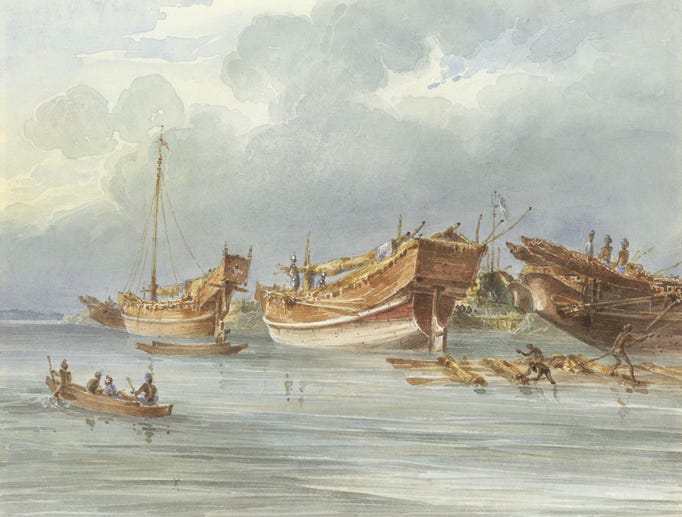
Asking what a society “looked like” is necessarily vague, but I think we’re beginning to see something. Mughal Bengal was a well-developed region with fertile land and a large population. It grew many different crops, from staple foods like rice to luxuries like cotton and silk. It had an efficient aristocracy that pushed for economic improvement by (of course) exploiting laborers. And it had large cities, ships, and waterways, meaning it had access to markets within India and abroad.
And so we can summarize the causes of Bengali proto-industrialization like this:
- High agricultural productivity supporting a large population
- Extensive waterway network, and lots of ships
- Proximity to raw materials (e.g. cotton was grown locally, unlike in Britain where it had to be imported)
- Incentives for the aristocracy to export goods
- Large number of laborers at subsistence level, in need of wage labor
- A few technological innovations (e.g. the improved cotton gin to spin thread)
- Some good economic ideas from Islamic law
- Access to large domestic and external markets, notably the Europeans.
On this last point: so far we’ve mentioned the European presence in India only in passing. But of course they had a huge impact on Bengal, especially once they turned from convenient trading partners to invaders who put an end to proto-industrialization. That’s what we’ll look at next.
III. In Which the British (Mostly) Ruin Everything
There’s a poem by Agha Shahid Ali that goes:
Those transparent Dacca gauzes known as woven air, running water, evening dew: a dead art now, dead over a hundred years. . . . In history we learned: the hands of weavers were amputated, the looms of Bengal silenced, and the cotton shipped raw by the British to England.
You may have heard the story; it is oft-repeated. The British, wanting to get rid of the Bengali competition to its own industries, horribly chopped off the thumbs of skilled cotton weavers, leading to the decline of the muslin industry and the destruction of India’s economy.
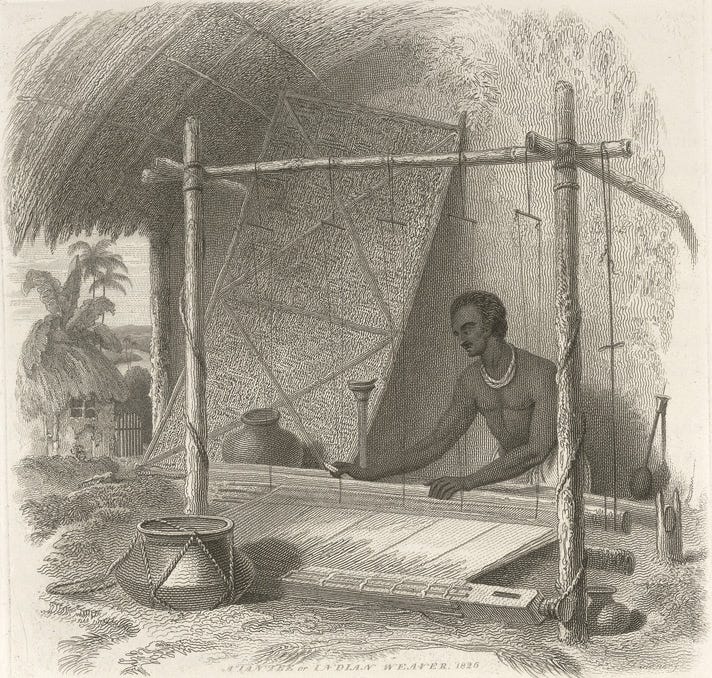
If this sounds too dramatic to be true, it’s because it isn’t. The story comes from a British East India Company employee called William Bolts, who wrote that some Bengali silk weavers cut off their own thumbs to that they wouldn’t be coerced to work. There are already discrepancies with the common story — it was silk, not muslin! and it was their own thumbs, they weren’t forcibly mutilated! — but even then, Bolts’s anecdote is probably also untrue. Most likely, it survived as a meme because it was (and is) a convenient piece of anti-British propaganda. A story that illustrates the cruelty of colonial rule.11
And it’s certainly correct that colonial rule caused great harm to South Asia. The British are responsible for a big part of the impoverishment that befell Bengal. Yet, the more I read about this, the more it seems that nuance is warranted. The Europeans didn’t simply lay waste to the region — after all, India produced luxuries that they wanted! — and the causes of deindustrialization are in large part the result of boring economic trends that are way less fun to talk about than blaming the colonial overlords for their atrocities.
To understand what happened, we need to know why Bengal came under the rule of Britain in the first place.
The direct involvement of Europeans with India began as early as ~1500. The Portuguese, having managed to sail around Africa to bypass the Middle East, set up some trading posts. India was a rich place, and merchants could make a killing by importing spices, muslin, silk, etc. for the European elites to enjoy. Over the next couple of centuries, investors from a few European countries — specifically Portugal, Britain, France, the Netherlands, and Denmark — created colonial companies to establish outposts on the subcontinent.

The colonial companies had their own military forces and strongholds. The British East India Company was headquartered in Fort William in Calcutta, for instance. The Compagnie française pour le commerce des Indes orientales built Fort d’Orléans a bit further north, in Chandernagore. These companies often came into conflict with each other and with the locals.
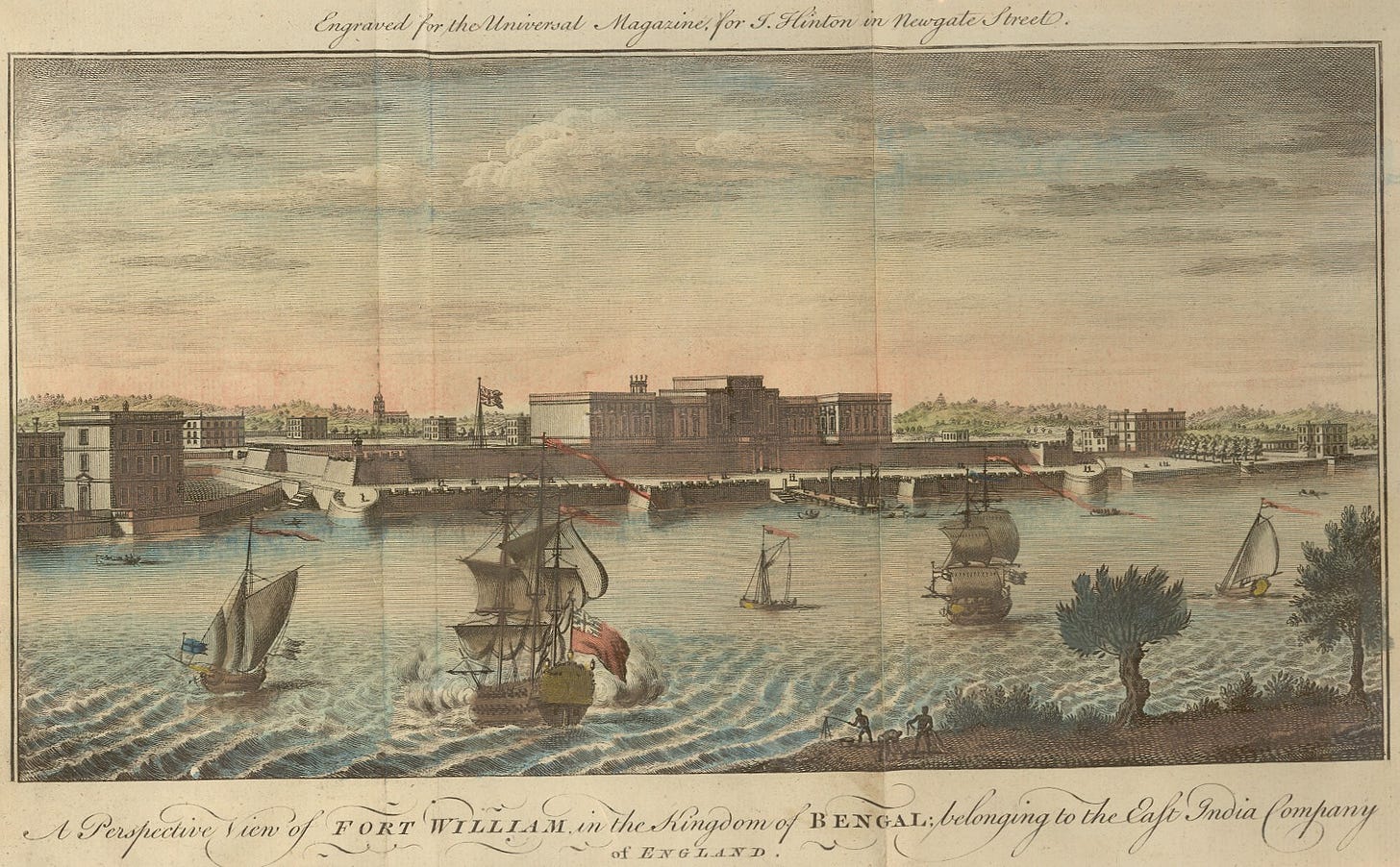
In 1757, the British East India Company won a crucial battle at Plassey against the Nawab of Bengal and his French allies, thanks to the defection of the Bengali commander-in-chief, Mir Jafar. After the battle, the Company installed Mir Jafar as the new (and conveniently British-aligned) Nawab. It then began a gradual process of seizing all the pieces of power, such as obtaining the right to collect taxes on behalf of the Mughal imperial government in 1765.
During the next several decades, the East India Company, and later the British crown, would end up controlling all of Bengal and almost all of India.
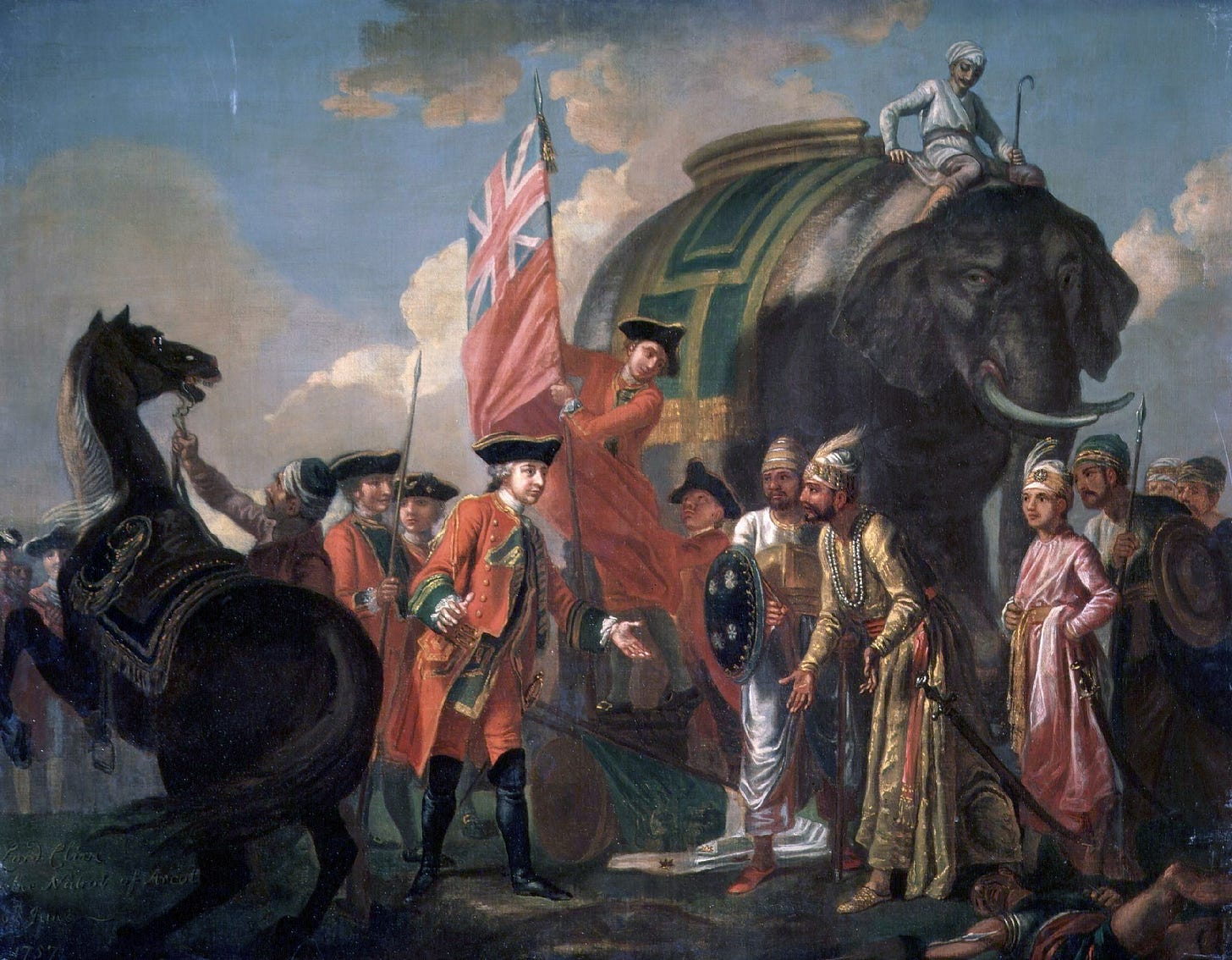
In some ways, the British colonization of India actually benefited Bengal. Since it was the first major region to be annexed by the Company, it remained a political center for a long time, and would later modernize faster than other regions of India. The city of Calcutta greatly developed around the Company’s headquarters. It was the capital of British India until 1911 as well as the hub of Bengali intellectual life, which eventually led to the Indian independence movement. It was also the home of Rabindranath Tagore, a legendary literary figure and the first Asian Nobel laureate.
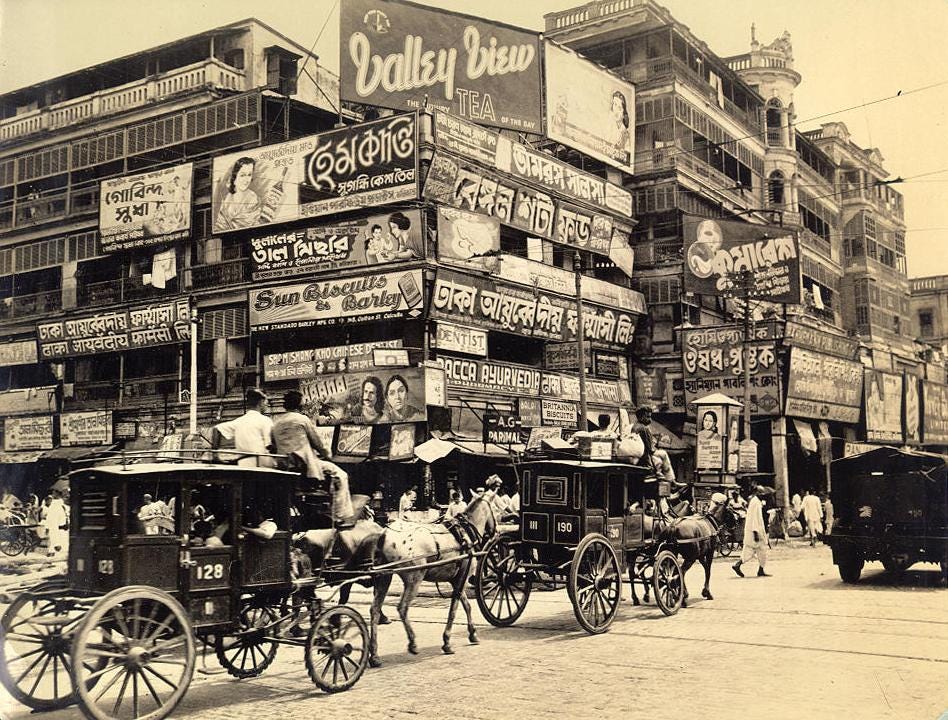
But of course, in many other ways, Bengal suffered. Soon after the conquest, the great famine of 1769-1770 killed millions of people. The East India Company was partly responsible due to its economic policies and choice not to provide much relief. Since they didn’t grow their own food, the weavers died in large numbers, which — combined with high tax rates and restrictions on trade — devastated the textile industries.
The city of Dhaka, erstwhile political capital and center of the muslin trade, declined very fast as Calcutta replaced it. As early as 1824, it was described as “a city of magnificent ruins.”

The deindustrialization of Bengal happened at the same time as, and is intertwined with, the industrialization of Britain. In case you were wondering, it is absolutely not a coincidence that the industrial revolution started circa 1760, mere years after the conquest of Bengal. Some of the plundered wealth from India provided the capital to kickstart textile factories and other industries in England. [ADDENDUM: Anton Howes points out that Britain was advanced in its proto-industrialization long before 1760, so don’t take the date at face value.]
And of course, once Britain was manufacturing industrial goods, it had to sell them somewhere. Annoyingly, the Indians were really good at making high-quality, inexpensive textile. The British weavers couldn’t compete! Earlier, when Bengal was a foreign country, Britain had tried to solve the problem with protectionist laws: the “Calico Acts,” passed in 1700 and 1721, banned the import of cotton textiles. [ADDENDUM: The story about the Calico Acts is more complicated than it looks; see this post.] But now Bengal was British, so it was easy to suppress its industries directly, by importing its raw cotton, making (inferior) textiles at home, and selling those textiles back to the Bengalis.
No need to chop off people’s thumbs when you can just force them to buy British-made cloth!
Ultimately, though, the main cause of Bengali deindustrialization goes deeper than famines and the disruptive actions of the East India Company. Simply put, Bengal couldn’t compete anymore. Europe was using the power of coal and machine tools to produce cheap textiles. It was impossible to keep up — unless you industrialized too.
And perhaps Bengal would have, if it hadn’t been a colony. Since it didn’t control its own economic policies, it couldn’t do what Britain did: set up protectionist trade barriers to develop its own industry safe from foreign competition. It was, like all colonies, in the awkward state of being forced to help with its colonial master’s economic development to the detriment of its own.
But what if things had played slightly differently? It’s time to speculate a bit.
IV. Could Bengal Have Undergone an Industrial Revolution?
Let’s begin by pointing out that I’m utterly unqualified to answer this question. Having said that, let’s try to answer it anyway.
Wikipedia names six requirements for an industrial revolution to take place:
- high levels of agricultural productivity to provide excess manpower and food
- a pool of managerial and entrepreneurial skills
- available ports, rivers, canals, and roads to cheaply move raw materials and outputs
- natural resources such as coal, iron, and waterfalls
- political stability and a legal system that supported business
- financial capital available to invest.
It should be pretty clear by now that Bengal was nailing #1 and #3. My understanding is that factor #6 was also present: Indian merchants were wealthy and had “considerable command over capital.” The Nawabs and their bankers, like the Jagat Seth family, certainly had the means to invest in private enterprise if they wanted to.
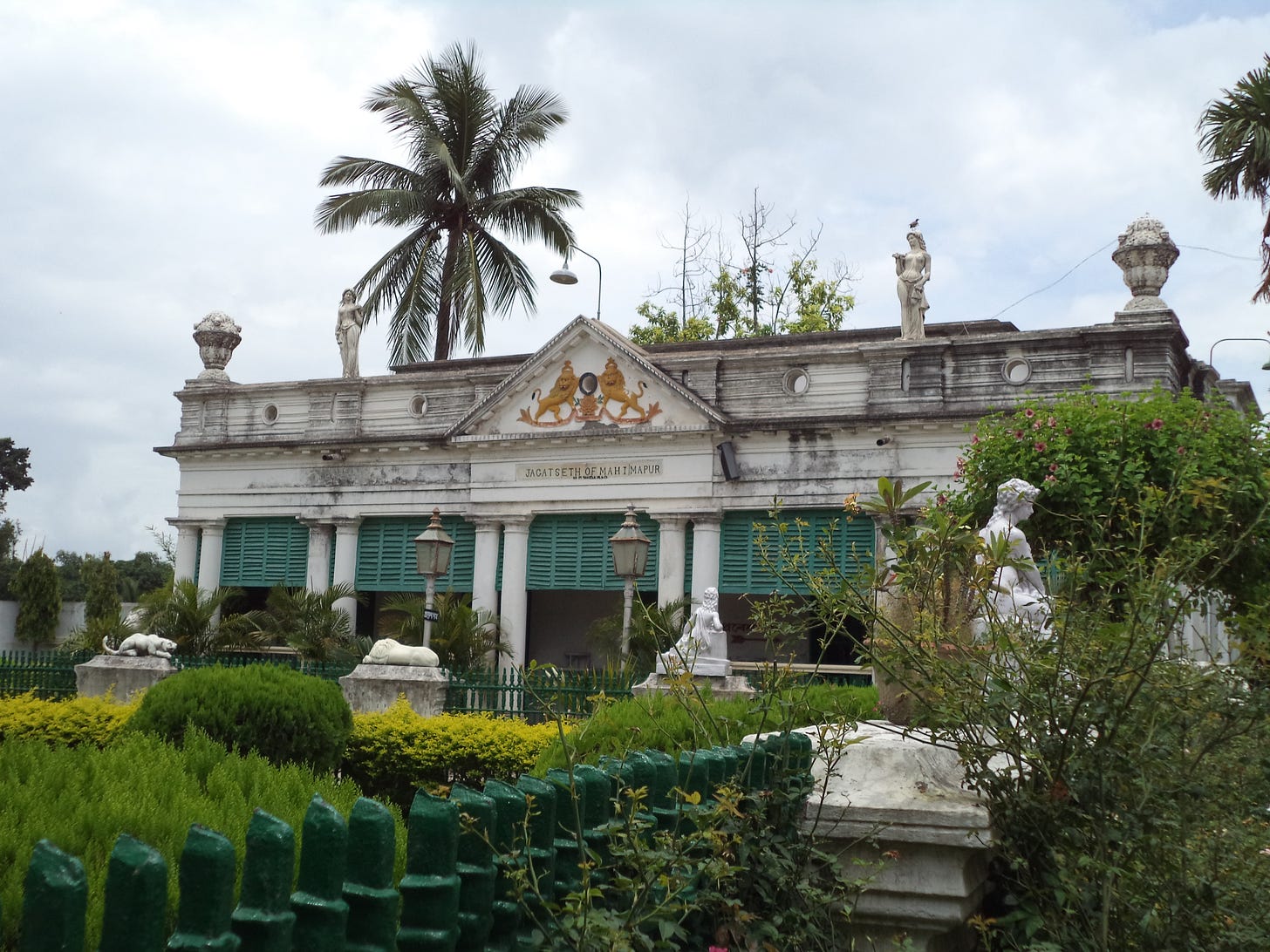
Factor #5 is directly related to the Islamic economics point we saw earlier. At first glance, it seems that the stability and laws of the Mughal Empire helped Bengal reach proto-industrialization in the 1600s. But later, the region experienced turmoil, and not only because of the European companies. The Mughal Empire began declining quickly from 1707 — that’s what allowed the Nawabs to become semi-independent. Then there were invasions by the Maratha Empire, a Hindu confederacy based in western India (they’re the yellow area in the 1760 map from section I).
Even internally, the economic system of Mughal Bengal wasn’t necessarily great. The emperor, viceroy, and zamindars frequently used their authority to enrich themselves through monopolies on some proto-industrial activities. Extortion and corruption were common.
Still, the governance couldn’t have been that bad, since proto-industries did prosper at least until the British conquest. What about factor #2 — managerial and entrepreneurial skills? That seems difficult to assess with precision, but I’ve been seeing hints that such skills were indeed lacking. The European companies, for example, brought innovation in organizational models, such as creating factory towns supported by wage labor. But local merchants did not copy them:
If this particular form of enterprise had been emulated by the Indian merchants with their considerable command over capital, revolutionary changes in the production of manufactured goods might have taken place. Why this did [sic] not take place? . . .
The non-occurrence of this form of indigenous enterprise in Bengal is comprehensively explained by flexibility of supply. The increase in production was achieved without any improvements in technique by primarily utilizing previously idle labour force.
If I’m understanding this right, there was so much available labor that the Bengalis didn’t need to innovate in either organization or mechanization. People also sometimes say that the Indians didn’t share the “capitalist mindset” of Europeans. My intuition says “doubt,” but it may be right that the Bengalis didn’t feel any strong incentives to improve on their proto-industries — until British rule began, and it was too late.
Lastly, factor #4 is about natural resources. Bengal had tons of natural resources. But did it have the right ones? Britain industrialized thanks to coal and iron. Moreover, it had to use coal because it suffered from deforestation. This was a happy accident that led to the steam engine and great advances in power generation. [ADDENDUM: This is likely wrong. Coal use led to deforestation, it wasn’t a response.] But in India there was no shortage of wood, and so:
British advances in cotton and coal were solutions to problems that did not exist in the Indian subcontinent.

The last few paragraphs suggest that, ironically, Bengal was too rich and populated to industrialize. It grew cotton on its own, it had enough wood to provide power, and it had many people who could be paid to make crafts. As a result, it didn’t really need to innovate, unlike a small and resource-poor (but coal-rich) country such as Britain. Whenever the demand increased, the Bengalis could simply get more people to do wage labor, or chop some wood, or clear some more marshes to grow cotton.
This makes some sense, but… I don’t know. My instinct is to not buy it. In general, I’m not a big fan of sweeping biogeographical explanations of history. If Bengal had sparked the industrial revolution, historians would be writing papers on how of course it couldn’t have happened in Britain first, since it didn’t grow cotton and had a small(ish) population!
So perhaps I’m out of my depth here, but I don’t get the feeling that the lack of industrialization in Bengal was a foregone conclusion.
There were certainly some missing ingredients, mostly incentives to innovation in organizational models, technology, and resource extraction. But later, when Indian industry fell behind Europe, those incentives became strong! There’s no fundamental reason that the merchants and landowners couldn’t begin innovating then. One could argue that Bengal was a traditionalist culture that didn’t value progress, but I don’t see why they couldn’t have learned from the ongoing European Enlightenment and see the benefits of progress for themselves. After all, today, India and Bangladesh value innovation just as much as anyone.
Therefore, my amateur answer is that yes, if Bengal hadn’t fallen under the dominion of the East India Company, it could totally have undergone an industrial revolution.
In alt-history, there can be an infinity of potential divergence points, but it’s nice to pinpoint the decision of a single person. In 1757, at the Battle of Plassey, Mir Jafar could have chosen not to defect. The Bengali and French armies would have prevented large-scale British colonization of the subcontinent. Great Britain would have been unable to plunder wealth to invest into its own economy, and its industrialization would have been slowed down (though not stopped). Meanwhile, Bengal would have controlled its economy; it would have developed or copied useful inventions; and it would have kickstarted its own industrial revolution.
And then the Great Divergence between Europe and Asia wouldn’t have happened, or it would have happened very differently.

Further reading
Note: inline footnotes were omitted due to formatting issues, but they are present in the original post.
Some relevant Wiki articles to start off your Wikipedia binge spiral:
Books that are relevant but that I have obviously not read in their entirety:
- A Century of Handicrafts in Rural Bengal, c. 1670-1770. A PhD thesis by Abhay Kumar Singh, 1989. I read the second chapter: “Origin and development of proto-industrialization in Bengal.” A warning: it’s typewritten and then scanned and therefore quite annoying to read.
- How India Clothed the World (there’s a PDF)
- Bengal Industries and the British Industrial Revolution (1757-1857)
- Why Europe Grew Rich and Asia Did Not: Global Economic Divergence, 1600–1850
- The Corporation That Changed the World: How the East India Company Shaped the Modern Multinational
Other stuff:
- r/AskHistorians: Bengal was supposedly one of the richest countries in the planet at one point. So what happened?
- Introduction to the concept of proto-industrialization
- A history of Bengali muslin fabric
- A paper on “India’s Deindustrialization in the 18th and 19th Centuries”
